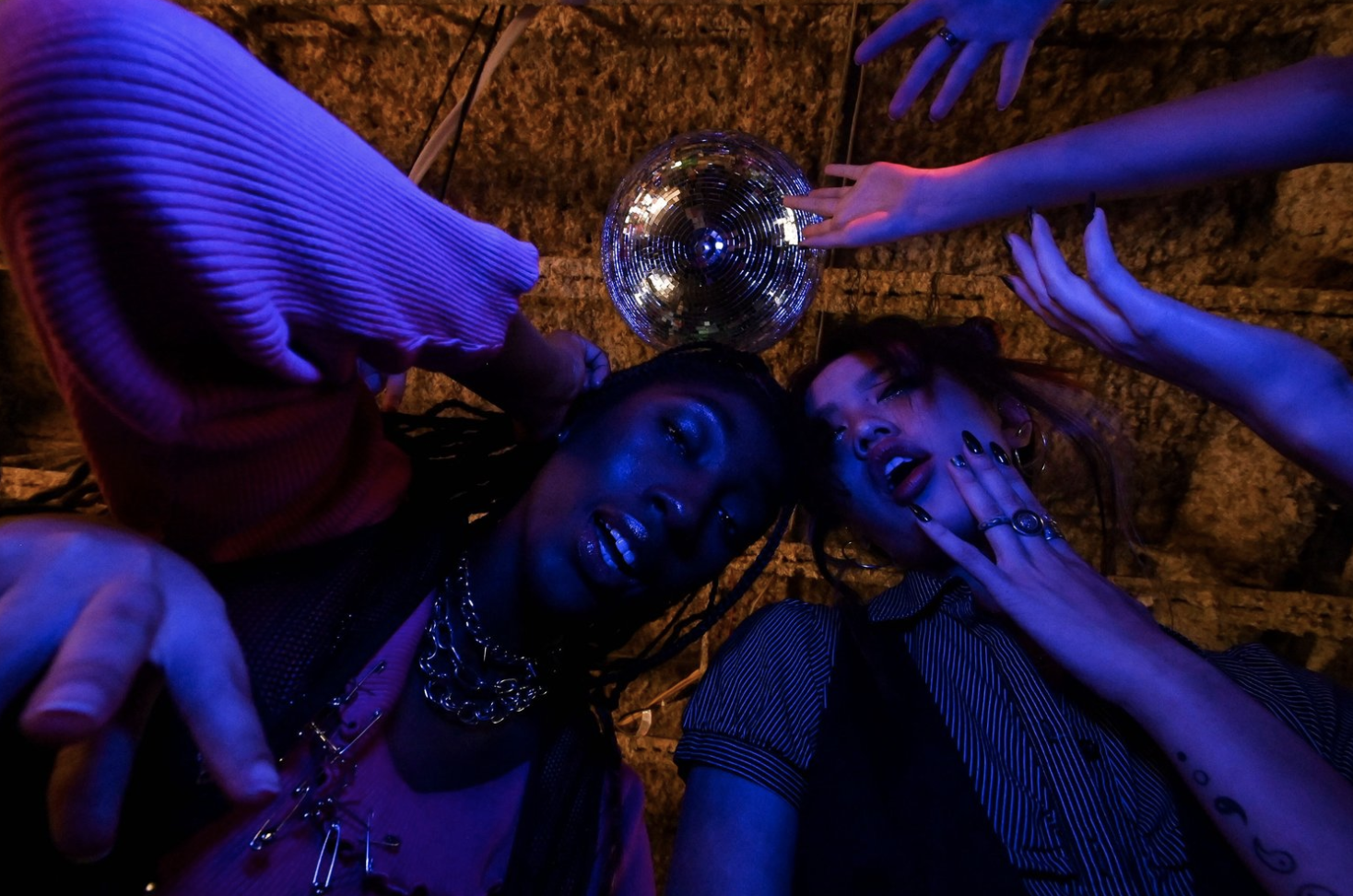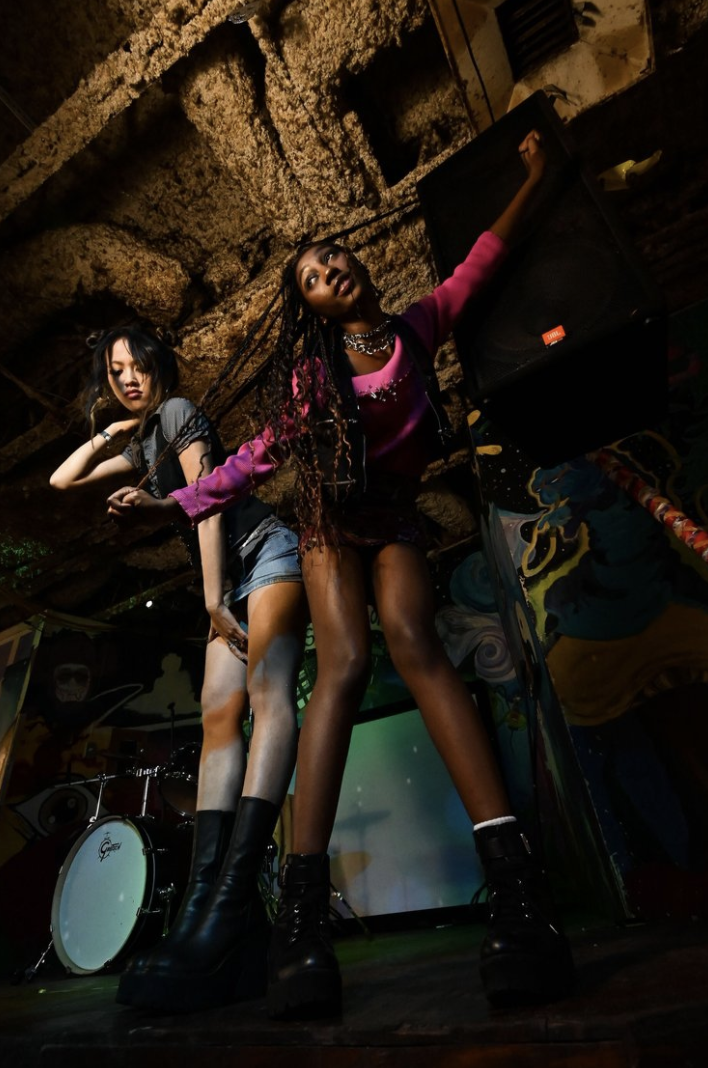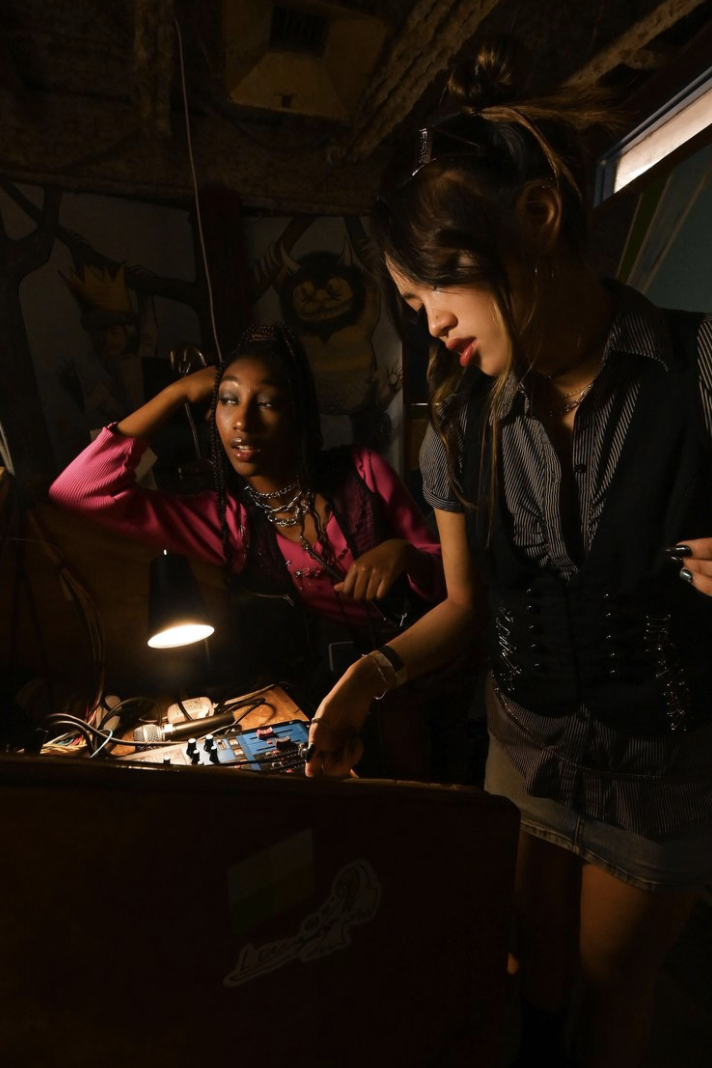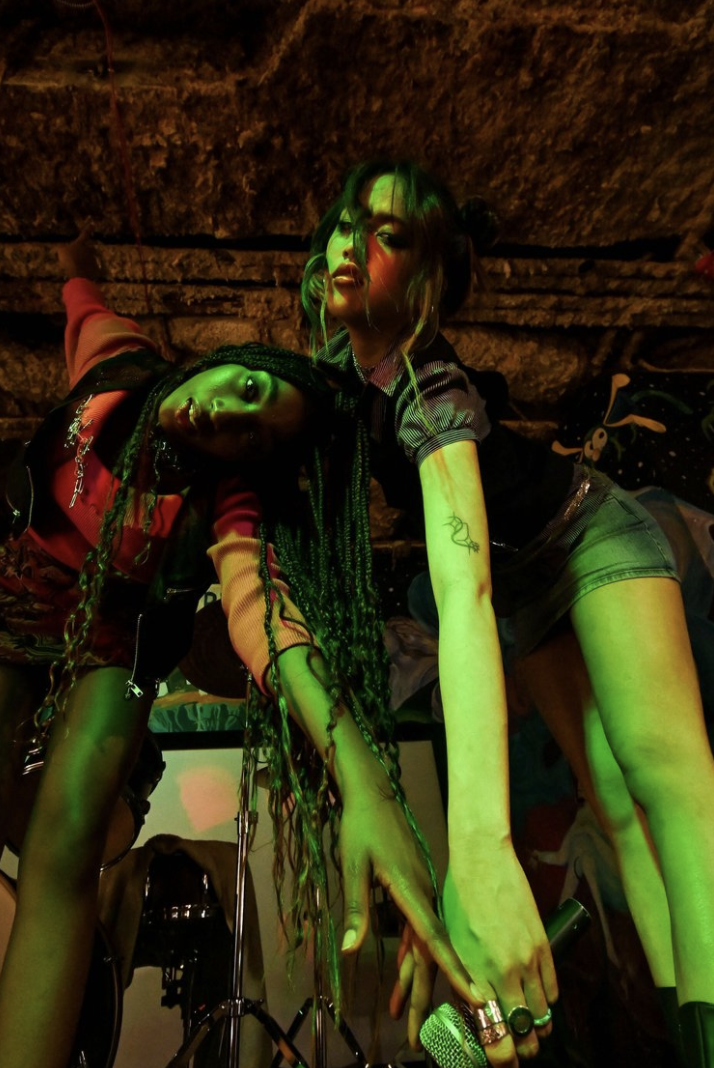Before PinkPantheress, There Was Bass
By Amber Weir
December 22, 2021

Photo by
Ren Breach
PinkPantheress is the embodiment of “New Nostalgia.”
In a London university hall at 3 a.m., PinkPantheress was awake sampling some old club anthems. Her uni work had kept her too busy to go and produce in a studio. So, she found inspiration in the solitude and darkness of the night.
She decided to upload a couple of tunes on TikTok: “Pain” and “Break it Off”. And just like that, she became an accidental celebrity.
PinkPantheress has a very mysterious online identity and prefers not to say her real name due to privacy concerns. Her sound was initially associated with her profile picture of Buttercup from the Powerpuff Girls. PinkPantheress also kept her internet success to herself until one of her friends messaged her group chat saying “this sounds like you” referring to one of her TikTok videos.
With this online success came a mixtape called “to hell with it” consisting of 18:36 minutes of anything and everything from jungle, garage, drum and bass, neo-soul to pop. PinkPantheress describes her music as “New Nostalgia,” blending old U.K. genres with a modern twist.
Many of PinkPantheress’s fans outside of the U.K. began to credit her with creating a whole new genre. She told NPR: “It's definitely important for people overseas to realize that DnB [drum and bass] and garage weren't started in my bedroom, it was started yonks and yonks ago by artists like Shy FX. It's a very ingrained part of UK culture.”
Music comes in cycles, and PinkPantheress is more than just a trend — she represents the constant evolution of British music.
But, where did it all start? A crowded basement in London.
In a London university hall at 3 a.m., PinkPantheress was awake sampling some old club anthems. Her uni work had kept her too busy to go and produce in a studio. So, she found inspiration in the solitude and darkness of the night.
She decided to upload a couple of tunes on TikTok: “Pain” and “Break it Off”. And just like that, she became an accidental celebrity.
PinkPantheress has a very mysterious online identity and prefers not to say her real name due to privacy concerns. Her sound was initially associated with her profile picture of Buttercup from the Powerpuff Girls. PinkPantheress also kept her internet success to herself until one of her friends messaged her group chat saying “this sounds like you” referring to one of her TikTok videos.
With this online success came a mixtape called “to hell with it” consisting of 18:36 minutes of anything and everything from jungle, garage, drum and bass, neo-soul to pop. PinkPantheress describes her music as “New Nostalgia,” blending old U.K. genres with a modern twist.
Many of PinkPantheress’s fans outside of the U.K. began to credit her with creating a whole new genre. She told NPR: “It's definitely important for people overseas to realize that DnB [drum and bass] and garage weren't started in my bedroom, it was started yonks and yonks ago by artists like Shy FX. It's a very ingrained part of UK culture.”
Music comes in cycles, and PinkPantheress is more than just a trend — she represents the constant evolution of British music.
But, where did it all start? A crowded basement in London.

Photo by Ren Breach
TRANSPORT YOURSELF BACK TO THE EARLY ‘90S.
In the early ‘90s America had hiphop, Jamaica had ragga, and Britain had jungle. Jungle music started as an underground sub-genre in the U.K. music scene and became a symbol of Nu Beginningz in London, where Djs began using dub reggae and Jamaican sound system culture. The music had sirens, rapid beatbreaks, syncopated percussion loops, extreme sampling, and — most importantly — very, very, very heavy drum basslines.
Before jungle, acid house was big in the U.K. rave scene and appealed to a predominantly white audience. Jungle Djs would sample old ragga and soul tunes, which resonated with Black Britons becauses it connected them to their roots. There’s nothing quite like being on a night out and hearing a song you recognize — it immediately draws the crowd to the floor.
To be an urban junglist, you had to wear baggy trousers, a colorful jacket, and a fresh set of air max ‘90s. The key to looking cool in the rave was to dress-down and to wear clothing that would set you free and let your body groove.
Of course, junglists were also anti-tory. In a post-Thatcherite society, music and clothing became a way for disillusioned youth to express themselves. The sound was much darker than other dance music such as techno, because it was the vessel to channel their discontent about society. Jungle souljahs called for good riddims and for revolution.
Congo Natty — proud junglist — said to The Guardian, “We were born in a soundsystem culture, and the soundsystem culture was about sound, word and power.”
LET’S RE-REWIND TO THE MID ‘90S.
As jungle music grew in cultural significance, the sound became much harsher. Many individuals — especially women — wanted to be able to groove on the dance floor. That’s when the U.K. garage scene emerged. U.K. garage was more in-line with club house music and it is where crowds could dance because the tempo was much faster and more soulful than jungle music.
As garage took off, there was a wave of optimism which was infiltrating the clubs. Following 18 years of tory rule, a New Labour government had just been elected. The garage crew were celebrating the end of tory austerity and there was hope for a regime change in U.K. politics. The clubs were booming, and — for this moment in time — life was good.
Fashion brands dominated the garage scene. There were garage men and garage girls. The classic look for garage men was Moschino jeans with a versace belt, and a pair of Gucci loafers. Garage girls were extremely glamorous wearing strappy tops, mini dresses and heels. Clothing was now a signal of status.
Garage did borrow the spoken word element from jungle music, which gave birth to the U.K. MC’s. The beats and words from this genre later inspired the beats for future grime stars like Skepta, Kano, and JME.
To summarize garage in the words of DJ Pied Piper & The Masters of Ceremonies: “We’re loving it loving it loving it, we’re loving it like this.”
As garage took off, there was a wave of optimism which was infiltrating the clubs. Following 18 years of tory rule, a New Labour government had just been elected. The garage crew were celebrating the end of tory austerity and there was hope for a regime change in U.K. politics. The clubs were booming, and — for this moment in time — life was good.
Fashion brands dominated the garage scene. There were garage men and garage girls. The classic look for garage men was Moschino jeans with a versace belt, and a pair of Gucci loafers. Garage girls were extremely glamorous wearing strappy tops, mini dresses and heels. Clothing was now a signal of status.
Garage did borrow the spoken word element from jungle music, which gave birth to the U.K. MC’s. The beats and words from this genre later inspired the beats for future grime stars like Skepta, Kano, and JME.
To summarize garage in the words of DJ Pied Piper & The Masters of Ceremonies: “We’re loving it loving it loving it, we’re loving it like this.”

Photo by Ren Breach

Photo by Ren Breach
ENTERING THE MID 2000S.
In the mid 2000s liquid funk became the predominant drum and bass genre. Liquid funk uses soft neo-soul vocals, echos, sampled drum loops, and natural sounds. The genre has instruments such as piano and guitars, rather than synth.
Listening to liquid funk is like being transported into a state of tranquil bliss. Dreamy, warm, and mellow — the bassline is extremely repetitive and creates a sense of reassurance. This is still a big sub-genre in the DnB community today.
Listening to liquid funk is like being transported into a state of tranquil bliss. Dreamy, warm, and mellow — the bassline is extremely repetitive and creates a sense of reassurance. This is still a big sub-genre in the DnB community today.
Anyway, back to PinkPantheress.
The reason PinkPanthress’s albums feel so nostalgic and familiar is because it is. When PinkPantheress started out, she didn’t feel comfortable making her own beats, so she began sampling from club classics. Her track “Pain” samples the garage mega-hit “Flowers” by Sweet Female Attitude and the Sunship, and “Break It Off” samples the drum and bass track hit “Circles” by Adam F.
Sampling is a beautiful way to pay homage to musicians who came before you and keep their music alive and circulating; it only helps the music scene by attracting a wider audience to works. PinkPantheress tries to be ethical by reaching out to the original artists, when possible, to see if they like her vision.
Drum and Bass is extremely alive in Britain and at the center of many university towns nightlife and certainly major festivals. Now, ravers wear air max 95s, tracksuits, and sunglasses — usually sourced from Depop. On a night out you can expect to hear a mix of old school and new wave jungle, garage, or liquid funk.
PinkPantheress brought this U.K. sound across borders with an anonymous identity illustrating how music is universal. She is not alone in sampling old club anthems. Grime star AJ Tracey has been releasing new wave garage tracks with beats from the past, one featuring Jorja Smith. Meanwhile, new wave jungle artist Nia Archives teamed up with old jungle star Congo Natty to create music which merges both new and old styles of drum and bass.
If you liked PinkPantheress’s album, here's her advice for you: “The first and foremost thing is if you like breakbeats and you like DnB, you need to tap into the British classics. Get a vinyl, go onto YouTube, type in Shy FX, type in Adam F, type in Sunship. I think if there's one thing I want people to know about me, it's that my music only scratches the surface of what real DnB is.”
There is not one absolute U.K. sound. The beauty in the evolution of U.K. music is how fluid sounds are and how they inspire infinitely more sounds. PinkPantheress is bringing awareness to a genre that started before her and will continue long after.
While we don’t know what genre will rise next, we do know from jungle, to garage, to liquid funk, there will always be a place in U.K. culture for drum and bass. ■
Models: Maliabo Diamba, Jillian Le, Presley Simmons
Stylists: Vi Cao, Kathleen Segovia
HMUAs: Emma Brey, Jordan Busarello, Emely Romo
The reason PinkPanthress’s albums feel so nostalgic and familiar is because it is. When PinkPantheress started out, she didn’t feel comfortable making her own beats, so she began sampling from club classics. Her track “Pain” samples the garage mega-hit “Flowers” by Sweet Female Attitude and the Sunship, and “Break It Off” samples the drum and bass track hit “Circles” by Adam F.
Sampling is a beautiful way to pay homage to musicians who came before you and keep their music alive and circulating; it only helps the music scene by attracting a wider audience to works. PinkPantheress tries to be ethical by reaching out to the original artists, when possible, to see if they like her vision.
Drum and Bass is extremely alive in Britain and at the center of many university towns nightlife and certainly major festivals. Now, ravers wear air max 95s, tracksuits, and sunglasses — usually sourced from Depop. On a night out you can expect to hear a mix of old school and new wave jungle, garage, or liquid funk.
PinkPantheress brought this U.K. sound across borders with an anonymous identity illustrating how music is universal. She is not alone in sampling old club anthems. Grime star AJ Tracey has been releasing new wave garage tracks with beats from the past, one featuring Jorja Smith. Meanwhile, new wave jungle artist Nia Archives teamed up with old jungle star Congo Natty to create music which merges both new and old styles of drum and bass.
If you liked PinkPantheress’s album, here's her advice for you: “The first and foremost thing is if you like breakbeats and you like DnB, you need to tap into the British classics. Get a vinyl, go onto YouTube, type in Shy FX, type in Adam F, type in Sunship. I think if there's one thing I want people to know about me, it's that my music only scratches the surface of what real DnB is.”
There is not one absolute U.K. sound. The beauty in the evolution of U.K. music is how fluid sounds are and how they inspire infinitely more sounds. PinkPantheress is bringing awareness to a genre that started before her and will continue long after.
While we don’t know what genre will rise next, we do know from jungle, to garage, to liquid funk, there will always be a place in U.K. culture for drum and bass. ■
Models: Maliabo Diamba, Jillian Le, Presley Simmons
Stylists: Vi Cao, Kathleen Segovia
HMUAs: Emma Brey, Jordan Busarello, Emely Romo
Other Stories in Culture
© 2024 SPARK. All Rights Reserved.
